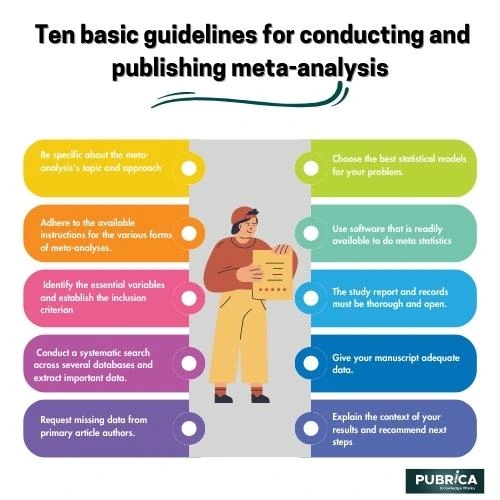
Manuscript Editing: What is It, and Why is It Important?
July 20, 2023
Variables Used in Data Extraction for Prospective Cohort Studies in a Systematic Review
August 16, 2023Ten Basic Guidelines for Conducting and Publishing a Meta-analysis
Meta-analysis is a statistical method used to combine and analyze data from multiple independent studies, allowing researchers to draw more robust and generalizable conclusions. The process begins with a research question, followed by a literature search, data extraction, quality assessment, effect size calculation, pooling, heterogeneity and sensitivity analyses, manuscript preparation and peer review. The publication of a valuable meta-analysis contributes to evidence-based research and informs future investigations in the field.

- To know more about Meta-Analysis Services, check our study guide. How to do a meta-analysis for a manuscript?
How do you carry out a meta-analysis?
Meta-analysis is a statistical technique used to synthesize and analyze data from multiple independent studies, aiming to derive more robust and precise conclusions than individual studies alone. To carry out a meta-analysis, meta-reviewer researchers follow specific steps. First, they define a clear research question and set inclusion/exclusion criteria for selecting relevant studies. Next, a comprehensive literature search is conducted to identify eligible studies. Data is extracted from each study, and its quality and bias are assessed. Statistical methods, such as effect size calculation and pooling, are then used to combine the data. Finally, results are interpreted, addressing heterogeneity and drawing meaningful conclusions to contribute to the existing knowledge base.
Conducting and publishing meta-analysis involves systematically synthesizing data from multiple studies on a specific research question. Here is an overview of the process:
Rule 1: Be specific about the meta-analysis’s topic and approach.
A systematic review is crucial for meta-analysis, using the PICO model to formulate research questions. Verify that no published meta-analysis on the specific topic to avoid duplication. Meta-analysis can be conducted for multiple types of studies, including epidemiological variables, genetic association studies, gene expression studies, genome-wide association studies, and animal experiments—Preregister systematic review protocols at PROSPERO to avoid duplication of efforts.
Rule 2: Adhere to the available instructions for the various forms of meta-analysis.
General guidelines for meta-analysis include the Quality of Reports of Meta-analyses of Randomized Controlled Trials (QUORUM) and the Meta-analysis of Observational Studies in Epidemiology (MOOSE) statements. The Preferred Reporting Items for Systematic Reviews and Meta-analysis (PRISMA) are widely used. Specific guidelines for clinical, genetic association, genome-wide expression, GWASs, and animal studies have been developed.
Rule 3: Identify the essential variables and establish the inclusion criterion
Establish inclusion and exclusion criteria for studies, avoiding strict language or sample size criteria. Clearly define variables extracted from each article. Broad inclusion criteria increase heterogeneity, while narrow criteria can make it difficult to find studies. A compromise should be found, and prospective meta-analysis, typically conducted by international consortia, offers the advantage of including individual-level data.
Rule 4: Conduct a systematic search across several databases and extract important data.
To systematically search published studies, use various bibliographic databases like PubMed, Embase, The Cochrane Central Register of Controlled Trials, Scopus, Web of Science, and Google Scholar. Specific databases like BIOSIS, CINAHL, PsycINFO, Sociological Abstracts, and EconLit can help identify additional articles and data. The Web of Science database can identify publications with key articles. Adequate extraction and recording of key data from primary articles is crucial for conducting a meta-analysis. Quality assessment of included studies, such as the Jadad scale for randomized clinical trials, the Newcastle-Ottawa scale for nonrandomized studies, and QUADAS-2 for diagnostic accuracy studies, is essential for determining inclusion criteria, sensitivity analysis, and differential weighting. However, quality assessment has been criticized for reducing studies to a single “quality” score.
Rule 5: Request missing data from primary article authors.
Key data in primary articles is often unavailable, requiring authors to contact them for missing information. Standards like MIAME and STREGA promote primary data availability, but strict criteria and specialized permissions may be needed in certain areas, like genetics, where aggregated statistics can identify individuals.
Rule 6: Choose the best statistical models for your problem.
Comprehensive meta-analysis are useful for analyzing high-quality primary data for quantitative summaries. However, analysts must be prepared for various transformations, such as extracting and transforming continuous variables, 2 × 2 tables, or survival data. These analyses often use fixed-effects or random-effects statistical models, combining ranks or p-values, or multivariate methods. Additional statistical examinations include sensitivity analyses, metaregressions, subgroup analyses, and calculation of heterogeneity metrics. It is crucial to assess and explain possible sources of heterogeneity, identify sources of between-studies variation, and quantify their impact on effect size. Publication bias, such as the “Proteus phenomenon” or “winner’s curse,” is important in certain scientific fields, and cumulative meta-analysis is suggested to identify them.
Rule 7: Use software that is readily available to do meta statistics
Meta-analyses are available in various programs, including Stata and R, which can handle complex analyses like network and gene expression studies. Stand-alone packages like OpenMetaAnalyst, NetworkAnalyst, JASP, MetaGenyo, Cochrane RevMan, EpiSheet, GWAR, GWAMA, and METAL are available for general applications or specific areas. However, some programs may present issues due to dependency on other packages.
Rule 8: The study report and records must be thorough and open.
Meta-analyses should follow guidelines to ensure transparency and replicability. Data on search criteria, abstract screening, and included studies is useful, along with meta-analytical strategies. Assessment of study quality is also important. A spreadsheet with step records can create flow charts, improving the meta-analysis’s quality. Records can be updated if needed, and stating limitations is crucial.
Rule 9: Give your manuscript adequate data.
A table with detailed information about included studies is useful in meta-analysis articles. It can be included in the main text or as a supplementary file. Reference software for meta-analyses and generate key graphs, including summary effect measures. Include plots from sensitivity analyses for positive findings. In complex analyses, include scripts used to generate results in supplementary files.
Rule 10: Explain the context of your results and recommend the next steps
The Discussion section is crucial in a meta-analysis manuscript, as it helps authors discuss findings in relation to existing literature and knowledge. It provides an interpretation of findings, comments on individual studies, and suggests future primary studies based on available evidence.
- Check our Meta-Analysis Servicesample work to know and learn more about, A meta-analysis of the relationship between Helicobacter Pylori infection and ABO blood groups.
Conclusion
Adhering to ten guidelines for conducting and publishing meta-analyses is crucial for producing high-quality research outcomes. These guidelines ensure relevant studies, assess study quality, and address bias using appropriate statistical methods for effect size calculation and pooling. Interpreting heterogeneity and conducting sensitivity analyses provide valuable insights, and transparent reporting and discussion of results enhance the research’s significance. These guidelines advance scientific knowledge, foster academic excellence, and enrich literature across various disciplines.
About Pubrica
The team of researchers and writers at Pubrica creates scientific and medical research articles that may be a vital resource for practitioners and authors. By educating the reader about the flaws or gaps in the chosen study field, Pubrica medical writers assist you in writing and editing the introduction. Our specialists are familiar with the format that moves from a broad topic, problem, and background to a focused topic where the hypothesis is stated.
References
- Forero DA, Lopez-Leon S, González-Giraldo Y, Bagos PG. Ten simple rules for carrying out and writing meta-analyses. PLoS Comput Biol. 2019 May 16;15(5):e1006922. doi: 10.1371/journal.pcbi.1006922. PMID: 31095553; PMCID: PMC6521986.
- Dekkers, Olaf M., et al. “COSMOS-E: guidance on conducting systematic reviews and meta-analyses of observational studies of etiology.” PLoS medicine 16.2 (2019): e1002742.

14 years of expertise in clinical research with a doctoral distinction in life science.


